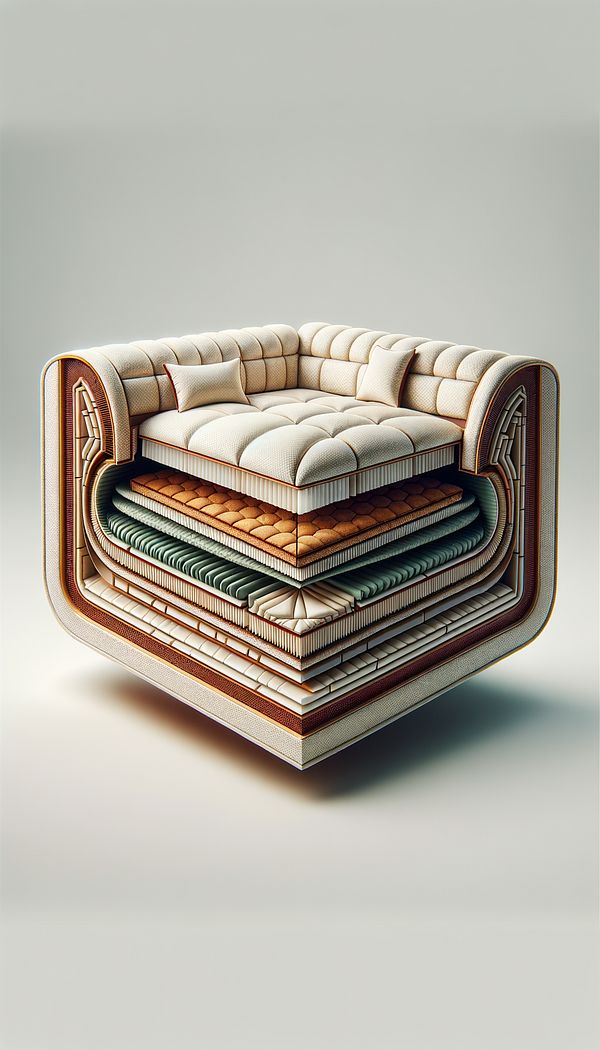What is a Inner Quilt?
A layer of padding enclosed between the outer fabric and lining of a piece of upholstered furniture.
Description
In upholstery and interior design, an inner quilt refers to a layer of soft material that is added between the outer fabric and the lining of upholstered furniture such as sofas, chairs, and beds. This layer serves several purposes, including providing comfort, adding structural integrity, and enhancing the overall aesthetic appeal of the piece. The materials used for the inner quilt may vary, including foam, batting, down, or synthetic fibers. The selection of material impacts the furniture’s comfort level, durability, and maintenance requirements.
Creating an inner quilt involves careful craftsmanship and an understanding of both materials and ergonomic needs. The process contributes significantly to the furniture’s overall quality and user experience, making it a critical aspect of furniture design and manufacturing. Interior designers and upholsterers commonly work together to select the appropriate materials and techniques that meet the client's needs and preferences, whether for residential or commercial spaces.
The design and composition of an inner quilt can also reflect certain design styles or periods, making it an element of interest for collectors and enthusiasts of historical and decorative furniture.
Usage
Inner quilts are commonly found in high-quality upholstered furniture such as luxury sofas, armchairs, and beds, where comfort and durability are paramount. Designers might specify the type and thickness of the inner quilt material to ensure it complements the furniture's design style and meets the ergonomic needs of the users. In historical furniture pieces, examining the inner quilt can provide insight into the craftsmanship and materials prevalent during that period.
FAQs
-
How does the inner quilt affect furniture comfort?
The inner quilt has a direct impact on furniture comfort by providing a soft, padded layer that enhances the user's seating or sleeping experience. The thickness and material type of the inner quilt determine its plushness and support.
-
What types of materials are used in inner quilts?
Common materials for inner quilts include foam, batting (including cotton, wool, or polyester), down, or synthetic fibers. The choice depends on the desired comfort level, durability, and maintenance ease.
-
Can the inner quilt be customized in upholstered furniture?
Yes, the inner quilt can often be customized according to the client's preferences, including the type of padding material, thickness, and distribution. This customizability allows for tailored comfort and specific design outcomes.
-
How can the selection of inner quilt materials impact the overall design of a piece of furniture?
The choice of inner quilt materials can influence the furniture's shape, firmness, and texture, contributing to the overall aesthetic and functional design. Higher quality materials may impart a more luxurious feel and appearance, while also affecting maintenance and longevity.
-
Is the inner quilt visible from the outside of the furniture?
No, the inner quilt is enclosed between the outer fabric and the lining of the furniture. While it's not visible, its presence is experienced through the enhanced comfort and structure it provides to the upholstered piece.
Practical Application
When selecting upholstered furniture, consider the type and quality of the inner quilt, especially if comfort and durability are top priorities. For those involved in designing or upholstering furniture, understanding the properties of different inner quilt materials and how they interact with other components is crucial. Tailoring the inner quilt to suit the design style and functional requirements can significantly enhance the overall quality of the furniture piece.
-
Design Styles478 articles
-
Furniture Types599 articles
-
Decorative Techniques322 articles
-
Materials & Textiles360 articles
-
ChintzChintz is a cotton fabric known for its glazed finish and elaborate floral patterns.
-
SideboardA sideboard is a long, low piece of furniture used for storage and displaying items, traditionally found in dining rooms.
-
PlushPlush refers to a fabric that is notably soft, thick, and luxurious.
-
JacquardJacquard is a fabric characterized by complex patterns woven directly into the material.
-
Chair and a HalfA chair and a half is an oversized armchair, larger than a standard chair but smaller than a loveseat.
